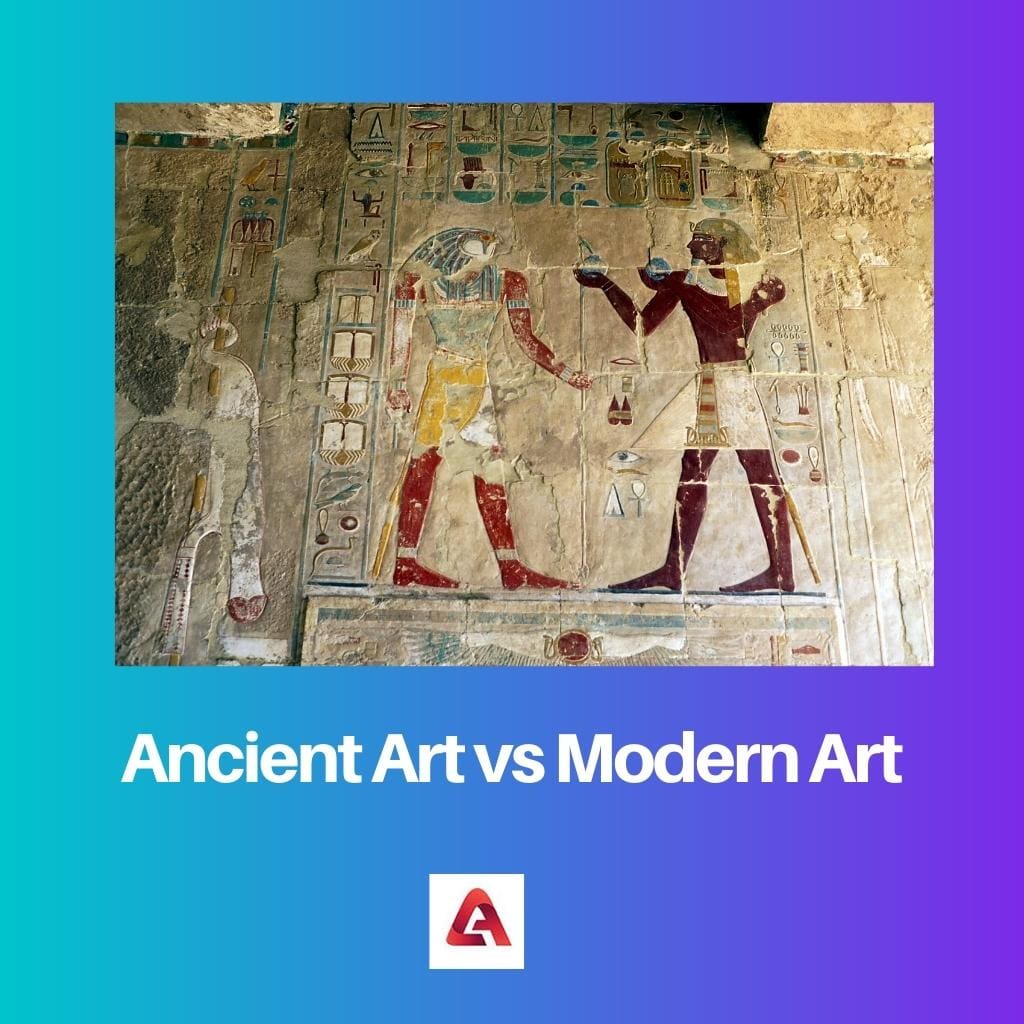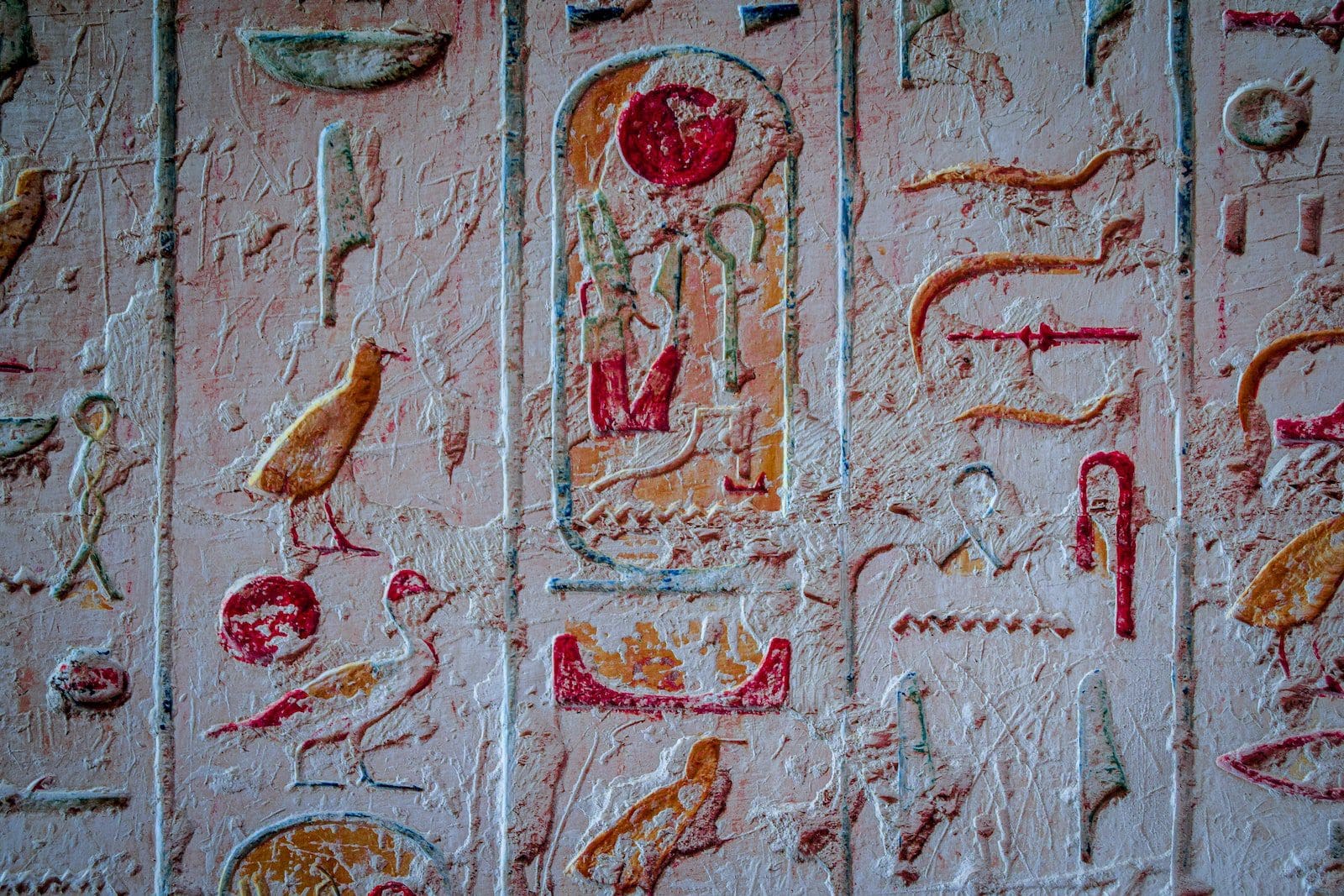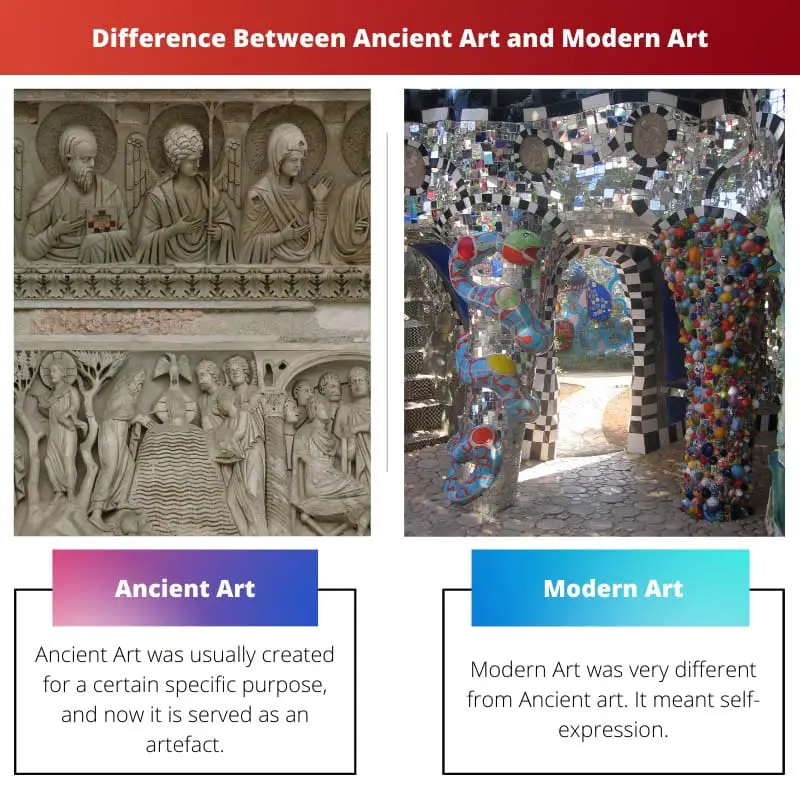Art is a way through which an artist shows his creativity and imagination to express the beauty, power, and ideas of what he/she observes and perceives.
Art can be any form, whether be it painting, sculpture, dance, architecture, etc. There is no exact description of What is Art? Because ideas and creativity change over time, and every person sees beauty and perceives imagination in their own way.
Art has been categorized in two ways: Ancient Art and Modern Art.
Key Takeaways
- Ancient art focuses on depicting religious or mythological themes, while modern art seeks to challenge traditional forms and conventions.
- Ancient art is representational, while modern art can be abstract or non-representational.
- Ancient art uses more natural colors and forms, while modern art uses a wider range of colors and explores new techniques and materials.
Ancient Art vs Modern Art
Ancient art refers to the art produced by civilizations that existed in the past, prior to the Middle Ages, and reflects the religious, cultural, and political beliefs of the time. Modern art refers to the art produced during the late 19th century and continues to the present day.

Ancient Art means the form of art which the people of advanced culture produced in the ancient age. It was prevalent in all the continents of the world, but most famously, it was found in Mesopotamia, Persia, India, Palestine, China, Egypt, Greece, and Rome.
Ancient art is seen as a historical archive that shows the history of mankind in the form of writings, paintings, sculptures, pottery, etc. Some of the famous artists of the age include Publius Aelius Fortunatus, The Malibu Painter, Quintus Pedius, Leonardo Da Vinci, Michelangelo, etc.
Modern Art refers to artistic work that was very different from ancient art and was popular between 18th-20th centuries. Modern Art was a period of experimentation, questioning, observing, and completely rejecting ancient art.
When Modern art emerged, it was the period of the world war when everything was in chaos, and people were skeptical, which led them to question things, and thus modern art was born.
Some of the famous artists include Vincent van Gogh, Paul Cézanne, Paul Gauguin, Pablo Picasso, Georges Seurat and Henri de Toulouse-Lautrec etc.
Comparison Table
| Parameters of Comparisons | Ancient Art | Modern Art |
|---|---|---|
| Definition | Ancient Art was created for a certain specific purpose, and now it is served as an artefact. | Modern Art was very different from Ancient art. It meant self-expression. |
| Epoch | It began from Paleolithic Age to the Middle Ages. | It began from the 19th century till the 20th century. |
| Art Movement | No art movements are related to it. | Several Art Movements like; Dadaism, Surrealism, Cubism, Expressionism etc. |
| Depiction | It depicted informally and conformed norms of the society. | It was formal and more expressive. It questioned everything. |
| Famous Works | Mona Lisa, Dionysus Cup, The Last Supper, Mask of Agamemnon etc. | The Broken Column, The Starry Night, Guernica, The Weeping Women, Tree Study etc. |
What is Ancient Art?
It is very difficult to trace the exact timeline of when Ancient Art began. Roughly speaking, it began somewhere in the Paleolithic age and continued till Middle Ages.
Ancient Art was produced for only certain purposes, such as ceremonial processes like burial, marriage, or any functions. Believed to be created by some of the advanced cultures of ancient societies like ancient India, Mesopotamia, Palestine, Egypt, China, etc.
This art is referred to as Pre-historic Art.
Ancient Art was informal and represented a particular culture, religion, politics, religion, and lifestyle. It also reflected the place of origin where the art originated.
Old civilizations always produced works of art that depicted their cultures, which differed from others. Ancient Art is used as a historical artifact by researchers and historians.
One of the famous works of Mesopotamian Civilization was known by the name ‘Cradle of Civilization.’
Ancient art depicted art in the form of pottery, sculpture, painting, architecture, and Calligraphy. One of the earliest art of pre-historic times was Bhimbetka Petroglyphs found in Central India.

What is Modern Art?
Modern art extends from the 19th century till the 20th century. It depicts the philosophy and styles of art. Modern art was basically the period of experimentation where modern artists wanted to create something new and fresh.
Modern Art is very opposite of Ancient Art. It questions opposition to traditional ideas and art and how they are expressed. It focuses on art related to modern changing times, different perspectives, ideas about the world, and the function of art.
The Heritage of Modern Art began with the painters like Paul Cézanne, Vincent van Gogh, Georges Seurat, Paul Gauguin, and Henri de Toulouse-Lautrec. These were considered pioneers of the modern form.
Modern art’s beginning can be traced to the Period of Enlightenment. Most important was the French Revolution, which was considered as the birth of many modernist concepts.
It started many art movements. Romantics, Realists, and Impressionists gave birth to modern art. In the 19th century, one more movement was added i.e., Symbolism.
In the 20th century, many other art movements sprouted up, such as Cubism, Fauvism, Expressionism, and Futurism. Modern art was introduced in the USA by Armory Shaw in 1913.
Modern Art is very unique in its sense and has a formal approach. It has a global appeal and doesn’t associate with one particular culture.

Main Differences Between Ancient Art and Modern Art
- Ancient Art was created for a certain specific purpose, and now it is served as an artifact. It reflects the particular culture, religion, and politics of the times. Modern Art is very different from Ancient art. It meant self-expression.
- Ancient Art began from Paleolithic Age to the Middle Ages. Modern Art began from the 19th century till the 20th century. It covered the period of the two World Wars.
- No art movements are related to Ancient Art. Several Art Movements are related to Modern art, like Dadaism, Surrealism, Impressionism, Futurism, Fauvism, Cubism, Expressionism, etc.
- Ancient Art depicted informally and conformed to the norms of society, and represented society as a whole. Modern was formal and more expressive. It questioned and opposed everything. It had a unique and global appeal.
- Famous works of Ancient Art: Mona Lisa, Dionysus Cup, The Last Supper, Mask of Agamemnon, etc. Famous work of Modern Art is The Broken Column, The Starry Night, Guernica, The Weeping Women, Tree Study, etc.


This article serves as a valuable resource for delving into the nuances of ancient and modern art. The clear and articulate discussion, along with the inclusion of notable works and artists, makes it an engaging and educational piece for art enthusiasts and scholars.
I completely agree, Rrose. The content of the article is both intellectually stimulating and comprehensively informative, providing readers with a nuanced understanding of the evolution of art over time.
This article provides an insightful examination of the characteristics and significance of ancient and modern art. The clear distinction between the two, along with examples of famous works and artists, enhances the depth of understanding offered to the reader.
I couldn’t agree more, Smith. The inclusion of specific examples of ancient and modern art helps to illustrate the concepts discussed, making it easier for readers to grasp the nuances of each art form.
Absolutely, Smith. The article has adeptly elucidated the essence of ancient and modern art, facilitating a better comprehension of these artistic movements.
The article effectively distinguishes between ancient and modern art, exploring the unique characteristics and significance of each. The comparison table is particularly helpful in summarizing the key differences between the two art forms.
I agree, Richardson. The comparison table serves as a succinct yet comprehensive reference point for understanding the disparities in the nature and context of ancient and modern art.
As an art history major, I found this article to be very informative and well-written. It provides a comprehensive overview of ancient and modern art, highlighting key differences between the two. Additionally, the comparison table is a useful tool for better understanding the contrasts between ancient and modern art.
I completely agree with you, Scarlett. The article effectively captures the essence of ancient and modern art, shedding light on their distinct characteristics and significance in the context of art history.
The article provides an in-depth exploration of ancient and modern art, delving into their respective characteristics, historical context, and prominent figures. The nuanced comparison between the two art forms adds significant value to the reader’s comprehension.
I concur, Peter. The comprehensive nature of the article, underscored by the detailed comparison between ancient and modern art, offers readers a holistic view of the evolution of art throughout history.
This article offers a detailed exploration of ancient and modern art, presenting the characteristics and significance of each in a lucid and compelling manner. The inclusion of notable artists and artworks enriches the narrative, making it a captivating read.
I share your sentiments, Elizabeth. The comprehensive nature of the article, coupled with the meticulous attention to detail, makes it an invaluable resource for both art enthusiasts and scholars alike.
Absolutely, Elizabeth. The depth of analysis and the clarity of presentation make this article an excellent source for gaining a deeper understanding of the evolution of art across different historical periods.
The comprehensive overview of ancient and modern art provided in this article is indeed impressive. The detailed analysis of various aspects related to these artistic movements adds depth and clarity to the discussion.
Absolutely, Proberts. The article manages to capture the essence of ancient and modern art, fostering a greater appreciation and understanding of these distinct periods within the realm of art history.
I couldn’t agree more, Proberts. The content of the article is informative and engaging, providing valuable insights into the evolution of art from ancient to modern times.
The article presents a thorough examination of ancient and modern art, shedding light on their distinct characteristics and the historical context in which they emerged. The insightful comparison table offers a concise summary of the defining features of each art form.
Absolutely, Reynolds Tiffany. The comprehensive overview provided in this article enriches the understanding of ancient and modern art, enabling readers to grasp the intricacies and significance of these artistic movements.
I share your sentiments, Reynolds Tiffany. The article effectively captures the essence of ancient and modern art, offering a compelling narrative that facilitates a deeper understanding of these artistic periods.
This piece meticulously outlines the evolution of art, from ancient to modern times. The detailed descriptions of ancient and modern art, along with the prominent artists of each period, make this article a valuable resource for anyone interested in art history.
Absolutely, Ymurray. The historical context provided for both ancient and modern art is particularly enlightening. The writers have done an excellent job of presenting this complex subject matter in a clear and accessible manner.
I found this article to be an engaging and enlightening exploration of ancient and modern art. The clear and well-structured analysis of key differences between the two art forms greatly enhances its value as a scholarly resource.